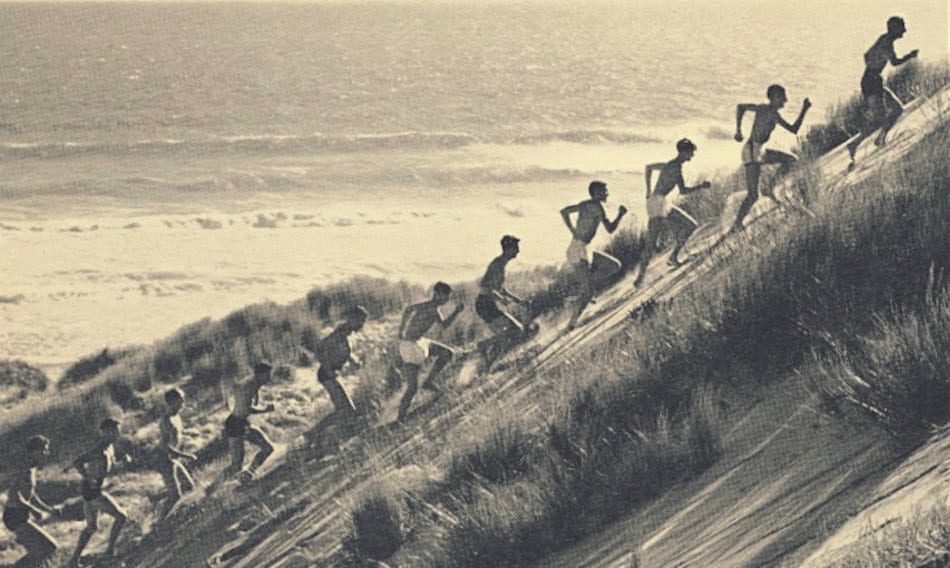By Len Johnson – Runner’s Tribe
I went bush walking this week. Nothing epic: a couple of nights’ camping in Victoria’s Grampians and walks to Mt Sturgeon and Mt Abrupt, and along the Wannon River to fill in the days.
Until now, I’d known the Grampians only by repute. We had visited Hall’s Gap once as a diversion from Stawell during the Easter Gift. I’d been to Hamilton, at the mountain range’s southern end, once before. A three-day bush walking trip hardly gives me much more of an overview of what the region has to offer, but did whet the appetite for more in a way the previous brief exposures had not.
My only other experience with walking, as distinct from running, was when we added on to a trip to Rio for the Olympics to hike the Inca Trial in Peru. Hardly your seasoned bush walker, then.
Though I didn’t fall on the tracks – despite the very best efforts of a dodgy right ankle – I did fall to recalling famous instances when bush walking had impinged on running in earlier times.
Many runners have been involved in bush walking over the years. Most famously, in an Australian context anyway, is probably Percy Cerutty’s involvement with the Melbourne Walking Club. Percy’s quest to rebuild his health and fitness started with walking: from there, the rest Is history. Pretty much his first published writing was a lyrical account of a hike to Tarli Karng, the sacred hidden body of water which forms the only lake in Victoria’s Alpine areas
“The first vistas of the lake, from an elevation some hundreds of feet above, disclosed a magnificent turquoise jewel deeply embedded in a glorious olive-green setting,” a lake “dwarfed by the immensity of the almost perpendicular mountains flanking it – grey-green walls reaching 2000 feet up to meet the translucent blue of the sky, and which, in turn, were reflected in celestial infinity in the great depths of the lake.”
Some years later, Les Perry, a member of Cerutty’s group when he made the 1952 Olympic team, used to walk through the same region with other running mates.
The most famous international link between running and walking – or rather, running, rock-climbing and walking – came during Roger Bannister’s successful chase for the four-minute mile. In his book The Four-Minute Mile, Bannister, who is not quite as lyrical as Percy, describes how he and training mates, Chris Chataway and Chris Brasher, could not quite achieve their training session of 10×440 yards in 60 seconds.
Following the Franz Stampfl schedules, the trio had started with 10 ‘quarters’ at 66 seconds, with two minutes between, in December, 1953. By April, 1954, they had progressed to 61 seconds but were despairing of reaching 60.
“However hard we tried, it did not seem possible to reach our target,” Bannister wrote. “We were stuck, or as Chris Brasher expressed it – ‘bogged down’. The training had ceased to do us any good and we needed a change.”
Brasher and Bannister drove up to Scotland, where they hiked and climbed for several days. Rejuvenated by the break, they came back, and – well, the rest is once again history.
Sore foot note: I’ve yet to return to training, but in don’t think I’m any more likely to achieve 10×400 in 60 seconds off two minutes than I was this time last week.
Doha standards finally make an appearance
Speaking of pedestrianism, the IAAF seems to have been moving at not much faster than a saunter in releasing the qualifying standards for Doha 2019.
Admittedly, the announcement that the switch to the new qualification-by-ranking system was put on hold only a week or so back, but unless that decision was made and announced on the fly, surely there was sufficient lead-time to release the standards simultaneously, or with minimal delay.
As it was, athletes in the Australian 50km race walking titles on 2 December, had to compete without an official announcement of the Australian selection policy (though they were given to understand the championship would carry its usual weight as a trial) which, in turn, was awaiting the release of the standards. It’s like someone had forgotten the southern hemisphere existed.
But all is sweet now as we head towards the Zatopek on 13 December, where the two 10,000 metres races retain Australian championship status. That’s the good news: the bad is that the men’s standard has been reduced from 27:45 to 27:40; the women’s, even more drastically, from 32:15.00 to 31:50.00.
Standards for several other events have also changed (see here), but it is more a case of tweaks rather than swingeing cuts. The main thrust of the system remains to control the numbers via the cap for each event, rather than the standard itself. The IAAF wants to add the final places, up to the limit in each event, via the ‘roll down’, rather than set an easier standard and have too many athletes meet it.
In that light, the increase in the cap for the men’s and women’s 5000 metres from 40 to 42 is far more significant than the tweak – by all of a tenth of a second – of the men’s standard from 13:22.60 to 13:22.50 (the women’s remains at 15:22.00). Likewise, the multi-events join the marathons in taking a significant cut in numbers – in this case the heptathlon and decathlon are both capped at 24 as against 32 in London last year.
Anyway, the standards are out now and we know exactly what is happening for Doha 2019. Can’t say the same for Tokyo 2020 and I don’t think we will know much more after a year’s shadow trial of the rankings.
